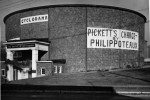 For a brief window in the 1870s and 80s, cycloramas were all the rage in the United States. The trend began with large-scale panoramas in the late 18th century. European artists pioneered the form, creating massive works that depicted famous battles, Biblical and mythological scenes, landscapes, famous explorers exploring exotic lands and more. This evolved into cycloramas, 360 degrees paintings installed in purpose-built circular buildings so that viewers on a central platform could have a full-immersion experience of being in the middle of the action.
For a brief window in the 1870s and 80s, cycloramas were all the rage in the United States. The trend began with large-scale panoramas in the late 18th century. European artists pioneered the form, creating massive works that depicted famous battles, Biblical and mythological scenes, landscapes, famous explorers exploring exotic lands and more. This evolved into cycloramas, 360 degrees paintings installed in purpose-built circular buildings so that viewers on a central platform could have a full-immersion experience of being in the middle of the action.
 Cycloramas caught on in the 1870s after the Franco-Prussian War inspired a proliferation of battle depictions. It was European artists who brought their techniques of creating massive 360 degree paintings to the United States. The Battle of Gettysburg, now at the Gettysburg National Military Park and the largest oil painting in the world, opened the cyclorama floodgates. French artist Paul Philippoteaux, who had been painting cycloramas in Europe since 1871, was commissioned to create the massive panorama by a group of Chicago investors in 1879. It took him two years and a couple of dozen of assistants to finish the piece. It went on display in Chicago in 1883 and was a runaway success, so much so that Philippoteaux was commissioned to make another three Battle of Gettysburg cycloramas.
Cycloramas caught on in the 1870s after the Franco-Prussian War inspired a proliferation of battle depictions. It was European artists who brought their techniques of creating massive 360 degree paintings to the United States. The Battle of Gettysburg, now at the Gettysburg National Military Park and the largest oil painting in the world, opened the cyclorama floodgates. French artist Paul Philippoteaux, who had been painting cycloramas in Europe since 1871, was commissioned to create the massive panorama by a group of Chicago investors in 1879. It took him two years and a couple of dozen of assistants to finish the piece. It went on display in Chicago in 1883 and was a runaway success, so much so that Philippoteaux was commissioned to make another three Battle of Gettysburg cycloramas.
 The Gettysburg blockbuster started a trend, and the same year it first went on display, German-born Milwaukee resident William Wehner founded the American Panorama Company. He had little difficulty investors that there would be a market in the United States for massive-scale views of scenes from the Civil War. The Battle of Atlanta, fought on July 22nd, 1864, was the chosen subject for the American Panorama Company’s second and most elaborate work, and little wonder since one of Wehner’s patrons was Illinois senator and Union Major General John “Black Jack” Logan who had commanded the Fifteenth Corps in the Battle of Atlanta.
The Gettysburg blockbuster started a trend, and the same year it first went on display, German-born Milwaukee resident William Wehner founded the American Panorama Company. He had little difficulty investors that there would be a market in the United States for massive-scale views of scenes from the Civil War. The Battle of Atlanta, fought on July 22nd, 1864, was the chosen subject for the American Panorama Company’s second and most elaborate work, and little wonder since one of Wehner’s patrons was Illinois senator and Union Major General John “Black Jack” Logan who had commanded the Fifteenth Corps in the Battle of Atlanta.
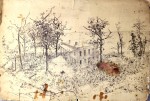 Wehner recruited a team of 20 artists from Germany, each experts in large-scale painting and specializing in certain areas — landscape, horses, human figures — and researched the battle assiduously. They had access to the sketchbooks and notebooks of Harper’s Weekly Civil War campaign artist Theodore Davis, official government documents and maps, spoke to veterans of the battle from both sides, and traveled to Atlanta so they could scope out the site of the battle with their own eyes. Even though the neighborhood where the battle took place (Edgewood, then an eastern suburb, now intown Atlanta) was completely unrecognizable just 20 years later, the artists were able to view tracks and landscape features by sketching from towers.
Wehner recruited a team of 20 artists from Germany, each experts in large-scale painting and specializing in certain areas — landscape, horses, human figures — and researched the battle assiduously. They had access to the sketchbooks and notebooks of Harper’s Weekly Civil War campaign artist Theodore Davis, official government documents and maps, spoke to veterans of the battle from both sides, and traveled to Atlanta so they could scope out the site of the battle with their own eyes. Even though the neighborhood where the battle took place (Edgewood, then an eastern suburb, now intown Atlanta) was completely unrecognizable just 20 years later, the artists were able to view tracks and landscape features by sketching from towers.
 The Battle of Atlanta made its debut in February 1887 in Detroit. Senator Logan had died in December of 1886 and the work was advertised as “Logan’s Great Battle” in homage to him. His cavalry charge to reinforce the Union lines was a featured scene in the cyclorama. Believe it or not, this massive painting more than 370 feet wide and just shy of 50 feet high was designed to be moved. After it was shown in Detroit, vast swaths of the canvas were draped on wooden frames and taken on the road where it was shown in Minneapolis and Indianapolis. The Cyclorama opened in Indianapolis in May of 1888 and by then Wehner’s company was in trouble. He sold The Battle of Atlanta to a local exhibitor. In 1890, that company sold it to promoter Paul Atkinson of Madison, Georgia.
The Battle of Atlanta made its debut in February 1887 in Detroit. Senator Logan had died in December of 1886 and the work was advertised as “Logan’s Great Battle” in homage to him. His cavalry charge to reinforce the Union lines was a featured scene in the cyclorama. Believe it or not, this massive painting more than 370 feet wide and just shy of 50 feet high was designed to be moved. After it was shown in Detroit, vast swaths of the canvas were draped on wooden frames and taken on the road where it was shown in Minneapolis and Indianapolis. The Cyclorama opened in Indianapolis in May of 1888 and by then Wehner’s company was in trouble. He sold The Battle of Atlanta to a local exhibitor. In 1890, that company sold it to promoter Paul Atkinson of Madison, Georgia.
 Atkinson put it on display in Chattanooga, taking it south of the Mason-Dixon line for the first time. It finally set foot in Atlanta in February 1892, where Atkinson put it on display in a wooden building on Edgewood Avenue, close to the battle site. In Atlanta, Atkinson promoted the one-time “Logan’s Great Battle” as the only painting of a Confederate victory, and he had it altered to make sure it fit the new pro-Southern narrative. A group of cowering Confederate prisoners were changed to retreating Union soldiers, for example.
Atkinson put it on display in Chattanooga, taking it south of the Mason-Dixon line for the first time. It finally set foot in Atlanta in February 1892, where Atkinson put it on display in a wooden building on Edgewood Avenue, close to the battle site. In Atlanta, Atkinson promoted the one-time “Logan’s Great Battle” as the only painting of a Confederate victory, and he had it altered to make sure it fit the new pro-Southern narrative. A group of cowering Confederate prisoners were changed to retreating Union soldiers, for example.

(It’s true that the Battle of Atlanta ended with the Union’s failure to take the city and the death of Major General James McPherson, one of the highest-ranking Union soldiers to fall in battle during the Civil War. General Sherman had to besiege Atlanta for more than a month before the city finally surrendered on September 2nd, 1864. Still, the one-day Battle of Atlanta was something of a Pyrrhic victory given the 5,500 Confederate casualties they could ill-afford this late in the war, and since the final conclusion of the wider fight for Atlanta was a decisive Union victory that played an important role in revitalizing Northern enthusiasm for the war and in re-electing President Lincoln, Atkinson’s pitch was more than a little disingenuous.)
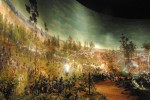 The days of the great panoramas in the round drawing crowds were over by then, however, and the Edgewood Avenue exhibition was financial failure. A year later, the painting was sold for a comparative pittance to Atlanta business magnate Ernest Woodruff. He quickly resold it to George V. Gress and Charles Northen. They had it repaired and installed in a new building in Grant Park, but again The Battle of Atlanta failed to attract visitors. In 1898, George Cress donated the painting to the City of Atlanta.
The days of the great panoramas in the round drawing crowds were over by then, however, and the Edgewood Avenue exhibition was financial failure. A year later, the painting was sold for a comparative pittance to Atlanta business magnate Ernest Woodruff. He quickly resold it to George V. Gress and Charles Northen. They had it repaired and installed in a new building in Grant Park, but again The Battle of Atlanta failed to attract visitors. In 1898, George Cress donated the painting to the City of Atlanta.
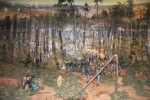 The city created a new building to house it in Grant Park in 1921. For some unfathomable reason, instead of just measuring the thing and making proper calculations, the new building which, once more for emphasis, was custom-built to house the painting, could not fit the whole painting. About eight feet of sky and a vertical section six feet wide were sliced out to squeeze it into the new Atlanta Cyclorama building.
The city created a new building to house it in Grant Park in 1921. For some unfathomable reason, instead of just measuring the thing and making proper calculations, the new building which, once more for emphasis, was custom-built to house the painting, could not fit the whole painting. About eight feet of sky and a vertical section six feet wide were sliced out to squeeze it into the new Atlanta Cyclorama building.
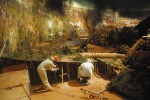 In 1936, a Works Project Administration team completed a diorama covering the space between the bottom of the painting and the edge of the viewing platform. On a red clay floor evoking Georgia’s characteristic russet heavy soil, landscape features, artillery, railroad tracks and 128 plaster soldiers were added to bring the painted scene into three dimensions. The soldiers ranged in size from 20 to 50 inches high and were placed to ensure they’d be in proper perspective and scale with the painting when viewed from the platform.
In 1936, a Works Project Administration team completed a diorama covering the space between the bottom of the painting and the edge of the viewing platform. On a red clay floor evoking Georgia’s characteristic russet heavy soil, landscape features, artillery, railroad tracks and 128 plaster soldiers were added to bring the painted scene into three dimensions. The soldiers ranged in size from 20 to 50 inches high and were placed to ensure they’d be in proper perspective and scale with the painting when viewed from the platform.
Condition issues proliferated over the decades at Grant Park. Twenty years of discussions from the late 1950s until the late 1970s considered a number of solutions to the problems, all of them rejected as too expensive. Finally between 1979 and 1982 the painted and diorama were conserved and the building renovated to include a revolving viewing platform.
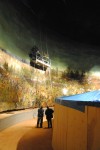 Since then, the painting continues to struggle with condition issues. Meanwhile, Zoo Atlanta, which shares space in Grant Park with the Atlanta Cyclorama and draws far, far larger crowds than the painting could ever dream of drawing, is keen to expand. In 2014, Atlanta Mayor Kasim Reed announced that the cyclorama would be moved to a new state-of-the-art facility at the Atlanta History Center‘s 33-acre campus in the toney Buckhead neighborhood.
Since then, the painting continues to struggle with condition issues. Meanwhile, Zoo Atlanta, which shares space in Grant Park with the Atlanta Cyclorama and draws far, far larger crowds than the painting could ever dream of drawing, is keen to expand. In 2014, Atlanta Mayor Kasim Reed announced that the cyclorama would be moved to a new state-of-the-art facility at the Atlanta History Center‘s 33-acre campus in the toney Buckhead neighborhood.
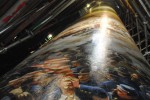 Moving a painting 359 feet wide and 42 feet high that weighs seven tons is not for the faint of heart. It has taken more than two years to plan and prepare the move. Earlier this month, the deed was done, in a painstaking series of steps.
Moving a painting 359 feet wide and 42 feet high that weighs seven tons is not for the faint of heart. It has taken more than two years to plan and prepare the move. Earlier this month, the deed was done, in a painstaking series of steps.
Workers, Mr. McQuigg replied, will spend days rolling the painting, which is appraised at $7.5 million, onto a pair of 6,200-pound spools. A crane will slowly lift the spools — “We’re hoping paint-drying goes faster,” Mr. McQuigg said in an interview — through seven-foot holes cut in the roof of the nearly century-old building. Then, once the shrink-wrapped painting is resting aboard two trucks, the workers will let the clock tick.
“We’re going to wait until everybody goes home and the traffic dies down and there’s no more Atlanta rush hour,” Mr. McQuigg said in the musty room where the cyclorama has hung for generations. “Heck, it might be 3 in the morning.”
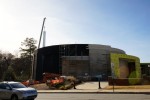 That’s pretty much what happened, although the two giant spools were raised on different days. The first scroll did end up being transported in the middle of the night to the new Lloyd and Mary Ann Whitaker Cyclorama Building at the Atlanta History Center. The second was moved during the day.
That’s pretty much what happened, although the two giant spools were raised on different days. The first scroll did end up being transported in the middle of the night to the new Lloyd and Mary Ann Whitaker Cyclorama Building at the Atlanta History Center. The second was moved during the day.
Now that they’re in the new building, the sections of the painting will be reunited and restored.
The restored painting will finally have the proper perspective: Until now, the painting hung like a shower curtain and there were folds and creases. When the painting reopens next year, the aim is to return the “immersion” effect.
The Battle of Atlanta will be displayed in its original hyperbolic, or hourglass shape. Through proper tension at the top and bottom, the painting’s horizon will appear closer to the viewer, restoring the original 3D illusion.
You’ll be able to see the whole painting: At Grant Park, patrons sat on a carpeted revolving grandstand, which kept them from taking in the entire painting at once. At the AHC, visitors will gaze from a platform 15 feet above ground. The diorama will be rebuilt. The idea is to remove as many obstructions as possible and let the painting make its own statement.
The Battle of Gettysburg is the same height as the Atlanta Cyclorama, but it’s 377 feet wide. When the restoration is complete, The Battle of Atlanta will get a little closer in width and beat it in height. The pieces cut out to squeeze Procrustes the Painting into the 1921 Atlanta Cyclorama building will be readded so that for the first time in almost a century, the complete panorama will be seen as the German painters created it. The restored cyclorama will be 371 feet wide and 49 feet high. The Atlanta Cyclorama will reopen to the public in the fall of 2018.
Here are timelapse videos of the two halves of the painting being scrolled up. The first half was scrolled on December 7th, 2016, the second on January 21st, 2017.
Here is the first scroll raised from a hole in the roof of the old Atlanta Cyclorama building and then being laid on the flatbed truck for transport to the new building.
This news story has film of the cranes lowering the massive scrolls into the new cyclorama building at the Atlanta History Center:
[youtube=https://youtu.be/pHJMvVom3Go&w=430]
As a longtime member of the International Panorama Council, I regard this move with very mixed feelings. We welcomed the move of the Gettysburg panorama, which similarly involved restoration of sky and returning it to it original height and form; it had been housed in a purpose-built structure on the battlefield, but that only dated to the 1960’s. The Atlanta Cyclorama, in contrast, was the last great-circle panorama still in a purpose-built structure — one which, when it was erected nearly a century ago, was the last such structure in the United States. It’s a significant historical loss to have this building no longer house its panorama (despite the size issues). The new building, judging from the architect’s rendering on the Cyclorama’s website, is an modernist monstrosity, whatever the merits of the display — it’s a shame that they didn’t opt for something more like the new Gettysburg venue, whose barn-like exterior harks back to panorama buildings past. Still, it is good news for the painting’s future that it is having proper restoration!
Just a footnote that I was a frequent visitor to the Gettysburg Cyclorama when it was housed on Cemetery Ridge, and recently had a chance to visit the new one back in the new visitor center in the artillery reserve area of the battlefield. The new one is better in every way, and serves the original purpose very well: You feel like you are in the middle of the battle, with things happening in every direction around you.
On busy days they bring people in one group at a time and pretty much have to chase everyone out after the formal guide’s talk, so everyone can get a chance. If you go on slower days – a Wednesday in February, for instance – you can stay a lot longer and question the park rangers to your heart’s content. There’s so much to see you can spend an hour looking at the thing.
I suspect something like ‘modern monstrosity’ was probably also applied to describe the original panorama buildings, back in the day. 😉
Sounds amazing. I would love to one day see it. I hope by complete restoration they’re also switching back the retreating Union soldiers to cowering Confederate prisoners like originally painted.